Todd Klein's Blog, page 107
August 24, 2020
Incoming: LEGION OF SUPER-HEROES OMNIBUS 1
 Image © DC Comics
Image © DC ComicsIn 1989, Keith Giffen and Tom and Mary Bierbaum relaunched a grim and gritty version of the Legion of Super-Heroes. I’ve just received this massive collection of the first half of that run, almost three inches thick. I lettered the first thirteen issues, but I have to say this was my least favorite version of the long-running DC super-team of the future, and I was happy to leave it behind. I’m sure it has fans, though, and if you’re one, you might want this collection. The retail price is $150, so you will need to really want it! Should be available soon in shops and online.
The post Incoming: LEGION OF SUPER-HEROES OMNIBUS 1 appeared first on Todd's Blog.
August 21, 2020
Ira Schnapp in GANG BUSTERS and MR. DISTRICT ATTORNEY
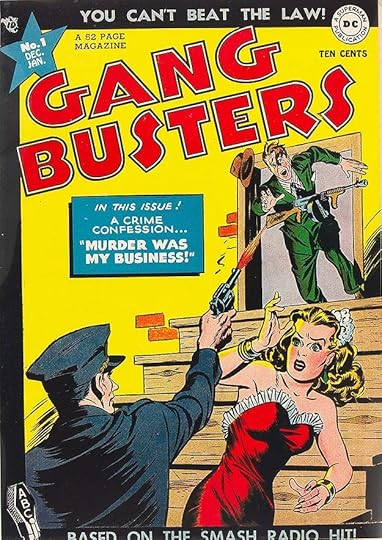 This and all images © DC Comics
This and all images © DC ComicsThe genre of “true crime” magazines became popular in the 1930s, often focusing on headline-grabbing gangsters like Al Capone and John Dillinger. The first comic to follow the trend was CRIME DOES NOT PAY by Charles Biro and Bob Wood for Lev Gleason Publications, beginning with issue #22 dated July 1942. It proved popular, and reached sales of over 1 milllion copies a few years later. Biro and Wood’s comics were known for their gore and violence and tackled adult subject matter like sex and drug use. Other publishers followed with similar comics, as is usually the case, with perhaps the most shocking content appearing in the crime titles from EC Comics in the early 1950s. DC (National) Comics entered the genre with this title’s first issue dated Dec. 1947-Jan. 1948, but it was tamer and less violent than crime comics from other publishers, and it was based on a popular radio show that ran from 1936 to 1957 and also spun off into a successful movie and a TV show. The radio show was overseen by FBI chief J. Edgar Hoover, and could only depict closed cases, but of course it played up the violence when possible. DC’s version seems to have tried to follow the radio show plan at first, but I don’t know if any of the comics were close adaptations of the radio programs or not. Certainly as the comic went on it veered off into more fanciful directions. I’m not sure who designed the logo and did the cover lettering for the first issue, it might have been Ira Schnapp, or it might have been the unknown letterer whose work inspired Ira that I’ve nicknamed Proto-Schnapp. Proto-Schnapp did a lot of inside page lettering for the title early on. Ira did very little, his work was mostly on covers, starting later.
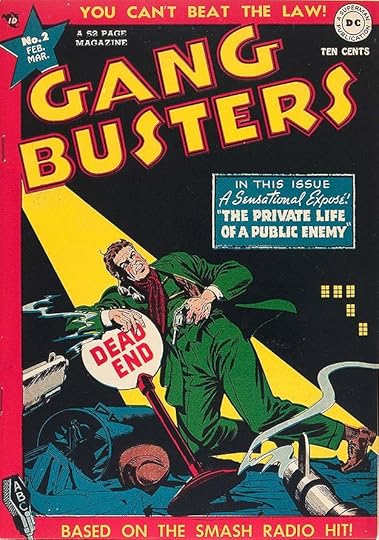
The cover of issue #2 has cover lettering that looks like Ira Schnapp work at first glance, but look at how rounded the S’s in the top line of the caption are, and also the rough, notched approach on the story title. These suggest Proto-Schnapp to me. Both letterers used that same script style seen in A SENSATIONAL EXPOSÉ! I think it’s likely by Proto-Schnapp, who I believe was an older man working on staff at the company. I’d say he was the cover letterer on these early issues.
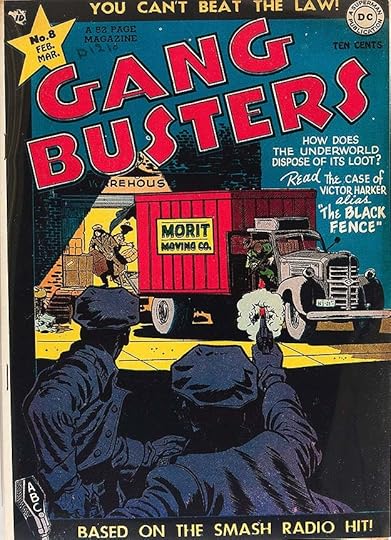
The first cover I think is lettered by Ira Schnapp is #8 dated Feb/March 1949, but again is might be by Proto-Schnapp. It’s hard to be sure.
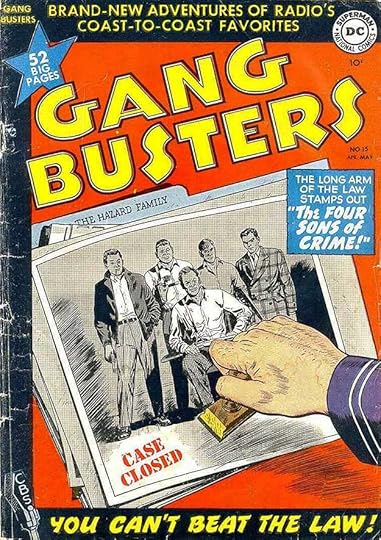
Issue #15, April/May 1950 is the first cover I feel sure is by Ira, though the bottom line is from an earlier cover lettered by Proto-Schnapp, and that tagline appeared on many later covers. Proto-Schnapp’s work disappears around this time, and I think he either died or retired around late 1949, and Ira replaced him as the staff letterer.
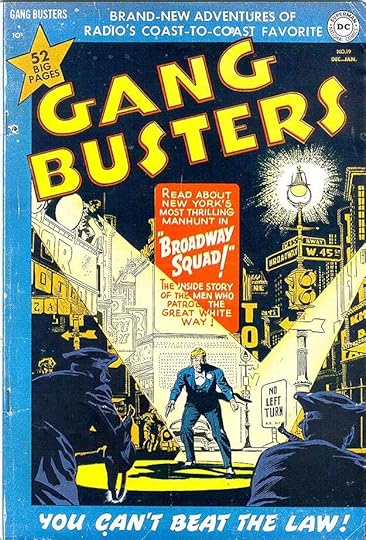
Issue #19 has one of the nicest Schnapp captions artfully color-separated to follow the spotlight beam.
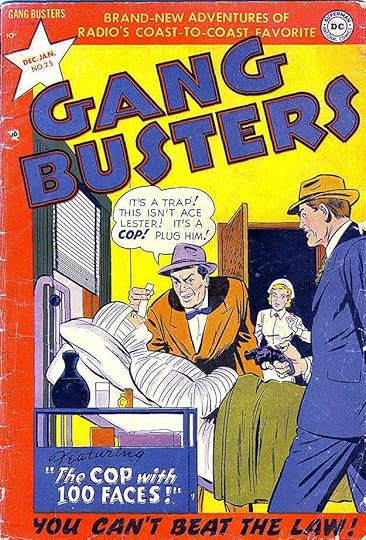
By issue #25, Dec. 1951/Jan. 1952, Ira’s familiar balloon and caption styles, used on most DC titles, had emerged, and were used often.
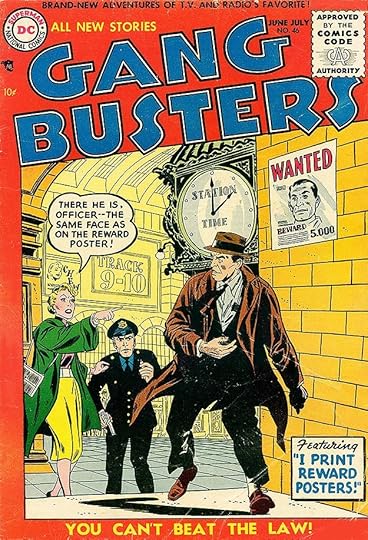
On issue #46, June/July 1955, Ira’s balloon and caption borders were thicker than usual, but in his familiar style.
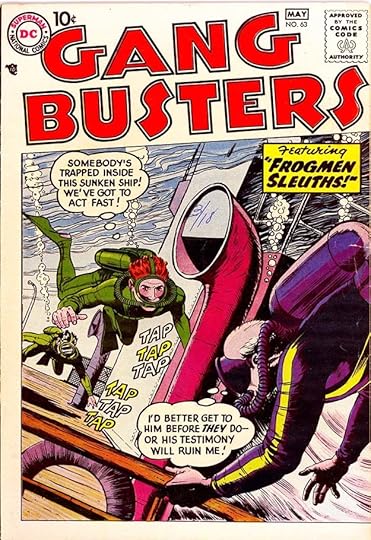
Here’s an example from late in the book’s run of more fanciful crime stories that surely never came from the FBI files.
I see Ira Schnapp lettering on the following covers: 15, 18-23, 25-42, 44-66. That’s 46 covers.
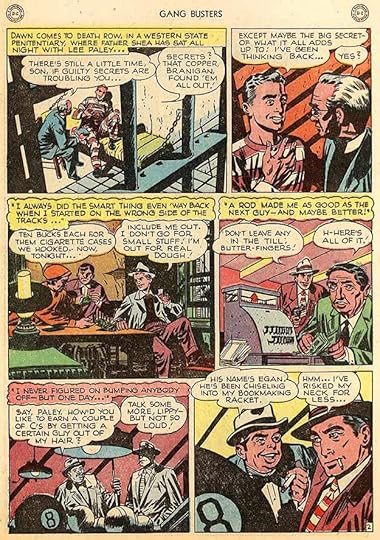
Here’s a story page from the first issue with typical Proto-Schnapp lettering. The style is similar to Ira’s, but notice how wide many of the letters are.
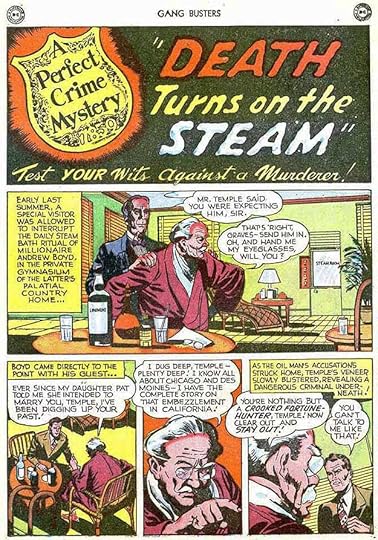
The first story lettering I see by Ira Schnapp is this four-page story in issue #11. Ira’s letters are genrally narrower and most would fit into a square.
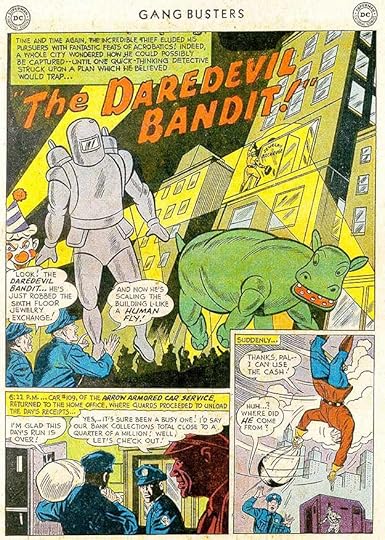
Ira did little interior lettering for the book, here’s an example from late in the run, issue #64. These are the stories I think Ira did:
#11 Aug/Sept 1949: A Perfect Crime Mystery 4pp (reprinted in #42)
#21 April/May 1951: A Casebook Mystery 4pp
#26 Feb/March 1952: A Casebook Mystery 4pp
#53 Aug/Sept 1956: G.I. Cop 6pp
#64 June/July 1958: The Daredevil Bandit 6pp
#65 Aug/Sept 1958: The Detective with 1,000 Traps 6pp
That’s 30 pages, a mere trifle for the always busy Ira Schnapp.
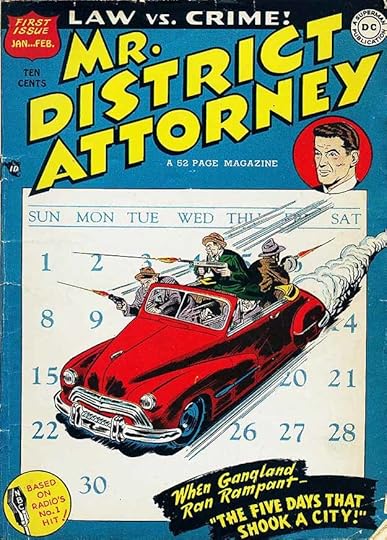
In 1948 DC launched a second crime comic also based on a popular radio show. This one had a regular protagonist, but he was unnamed, going only by the title of this comic. The style of this logo is similar to GANG BUSTERS, and the lettering on this cover is by Proto-Schnapp, who lettered many early covers and many stories in the first dozen issues. Perhaps Proto-Schnapp also designed the logos for both books.
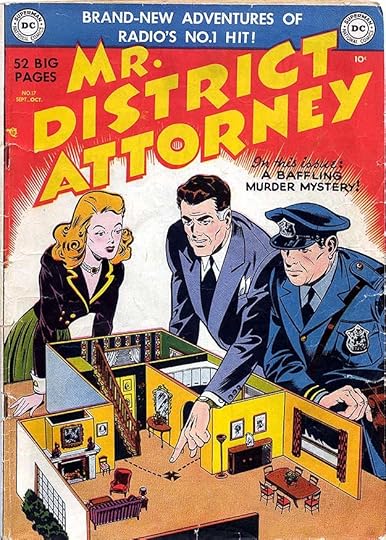
The cover of issue #17, Sept/Oct 1950, is the first one I think is lettered by Ira Schnapp, though it could be by Proto-Schnapp. His work had largely vanished by this time, but the cover could have been prepared ahead of schedule. Starting with issue #19 I see more convincing Ira Schnapp lettering on many covers of this series, though some were lettered by another person.
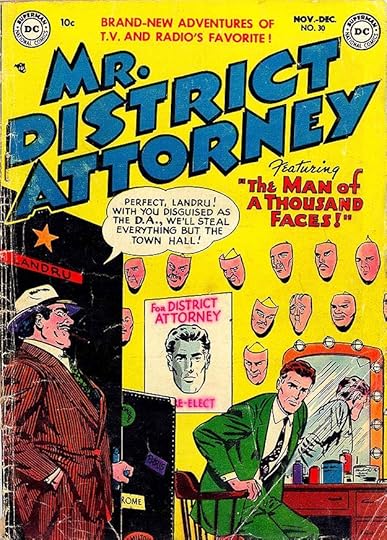
By issue #30, Nov/Dec 1952, the cover lettering had taken on the familiar look of most DC covers of the time by Ira.
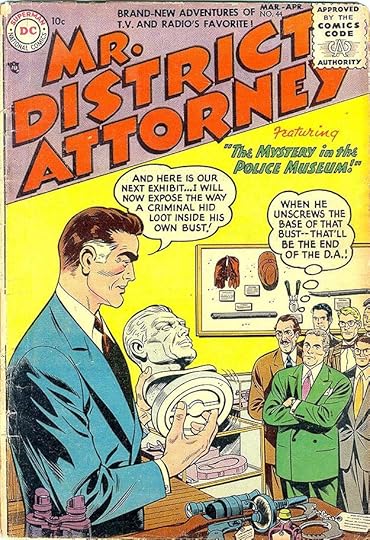
Issue #44 has a rare example of a thought balloon in this series, as readers were generally kept out of the character’s heads, as in a radio drama.
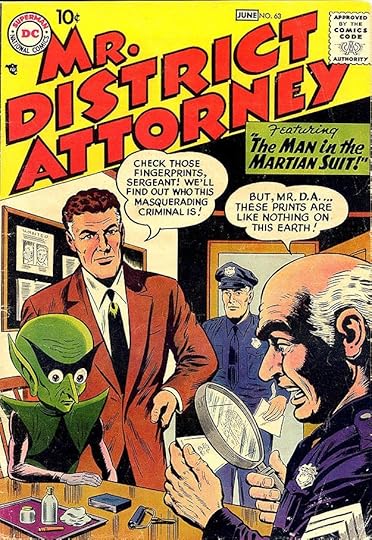
As the series neared the end of its run, sillier and more desperate plot ideas became more common, as on this cover of issue #63.
I see Ira Schnapp lettering on the following covers: 17 (probably), 19-20, 23-24, 28, 30-48, 50-51, 53-66. That’s 39 covers.
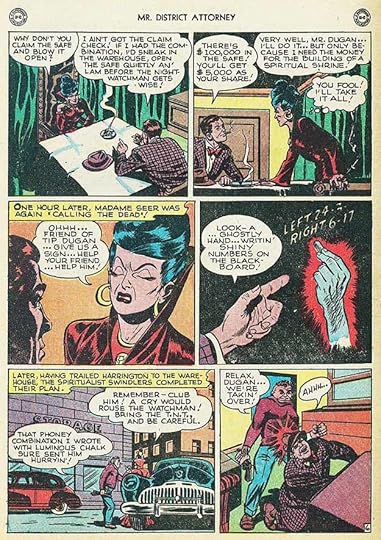
Here’s a typical page of story lettering by Proto-Schnapp from the first issue.
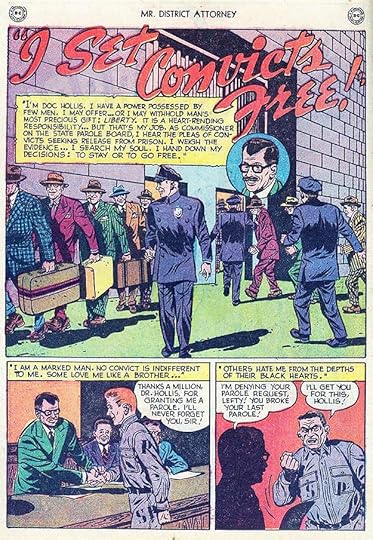
Here’s the first story I think was lettered by Ira Schnapp. Both he and Proto-Schnapp used this kind of script title letters, but the narrow width of the balloon letters overall suggests Ira to me.
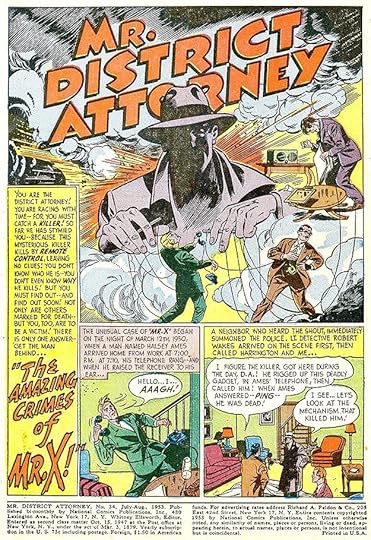
Again, Ira did very little story lettering for this title. Issue #34 had this example, one of three he lettered, perhaps filling in for someone. Stories in these two titles were often full of lettering, with many pages about half art and half lettering, so I’m sure they were a chore to get through. Perhaps Ira’s position as an on-staff letterer gave him more choice of which books he preferred to work on, and certainly he did a lot more on humor and romance titles.
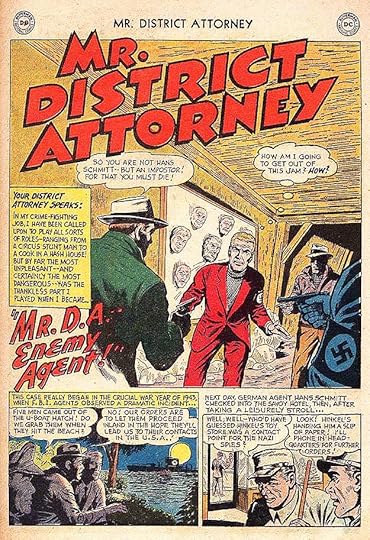
Here’s the final Ira Schnapp story lettering in the book from issue #65. I found Ira’s story lettering only in these issues:
#8 March/April 1949: I Set Convicts Free 8pp
#34 July/Aug 1953: Headquarters Underground 6pp, The Crimes of Charlie the Actor 6pp, The Amazing Crimes of Mr. X 8pp
#41 Sept/Oct 1954: The Cruelest Racked in the World 6pp
#65 Sept/Oct 1958: Mr. D.A. Enemy Agent 6pp
That’s a total of 40 pages on this title. More articles in this series can be found on the Comics Creation page of my blog.
More about the Gang Busters radio show is on this Wikipedia page.
More about the Mr. District Attorney radio show is on this page.
The post Ira Schnapp in GANG BUSTERS and MR. DISTRICT ATTORNEY appeared first on Todd's Blog.
August 17, 2020
Ira Schnapp in FUNNY STUFF
 This and all images © DC Comics
This and all images © DC Comics FUNNY STUFF was a funny animal title from All-American Comics, the sister company of National (DC) Comics. Their editor-in-chief, Sheldon Mayer, was a funny animal artist and writer himself, and I think he designed this logo, but I don’t know who did the rest of the cover lettering, which is quite good. It’s nothing like the work of Ira Schnapp, who did no work for All-American titles until after the company merged into a shared office with DC around 1946. Mayer probably continued to edit for a while, and after he left staff to do freelance work, it would have gone to Larry Nadle, who edited all the DC humor books at the time. The title ran from Summer 1944 to issue #79 dated July/August 1954.

Many FUNNY STUFF covers had no lettering. The first one I think has lettering by Ira Schnapp is issue #51, above, dated Nov/Dec 1949. It’s not completely typical of Ira’s cover work, but uses all Ira styles, and the handling of the word YOU convinces me Ira did it.

The cover of issue #53, March/April 1950, has a more typical Ira word balloon, though still not quite in the familiar style of his later work.

By issue #68, Sept/Oct 1952, Ira’s cover balloon style was well established, though his use of bold emphasis here is still not quite the usual one.

Issue #73, July/Aug 1953 is very much in the typical Ira Schnapp cover balloon style familiar on many titles through the 1950s and early 1960s. Ira’s work on covers was larger and more carefully done than his interior page lettering, and always appealing.
Here are all the covers I see Ira’s lettering on: 51, 53, 59, 61, 66, 68, 70, 72-73, 75-79, that’s 14 covers.
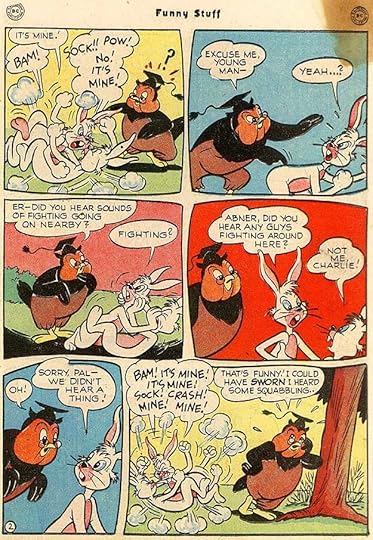
All-American had their own regular letterers, none of whom I can name, some quite good. After the companies merged, their work continued for a while and was gradually replaced by DC’s regulars including the unknown person I’ve nicknamed Proto-Schnapp because I think his work inspired Ira’s own style. The first story I think was lettered by Ira is this one featuring Ozzy Owl from issue #44 dated April 1949.

From issue #49, Sept. 1949, Ira’s story lettering began appearing regularly on about a third of the stories in each issue. This coincides with his increased workload around that time on many other DC titles. Proto-Schnapp’s lettering vanishes by 1950, so I think he either retired or died, and that’s when I think Ira replaced him as a regular staff person, coming in to work in the offices every day, and also taking on much of Proto-Schnapp’s workload. The lead feature on FUNNY STUFF at the time was The Dodo and The Frog, and Ira lettered many of their stories like the one above from issue #52.

Ira lettered many other short stories, some with scripts and art by Sheldon Mayer, as in this page from issue #68. I think the POW! sound effect here is all Mayer’s work, as it’s not typical of Ira’s sound effects. After leaving staff, Mayer seemed to be happy doing funny animal stories like this, and he continued to work on them and other features he created like Scribbly and Sugar & Spike the rest of his life.

The final issue, #79, has a Dodo and the Frog story where all Dodo’s word balloon are upside down, which must have been an interest lettering challenge for Ira, and for the readers too. FUNNY STUFF continued for a while as the title DODO & THE FROG, and I’ll look at that later.
Here’s a list of all the stories lettered by Ira Schnapp in this title:
#44 April 1949: Ozzie Owl 7pp
#49 Sept 1949: Blabber Mouse 6pp, Blackie Bear 6pp, Ozzie Owl 6pp
#50 Oct 1949: Rufus Lion 8pp
#51 Nov 1949: Blackie Bear 6pp, Dodo & Frog 2pp, Rufus Lion 7pp
#52 Jan/Feb 1950: Dodo & Frog 6pp (1st), Rufus Lion 7pp, Blackie Bear 6pp, Bernard 6pp, Dodo & Frog 6pp (2nd)
#53 March/April 1950: Blabber Mouse 6pp, Dodo & Frog 2pp
#54 May/June 1950: Blabber Mouse 6pp, Rufus Lion 7pp, Blackie Bear 6pp
#55 July/Aug 1950: Dodo & Frog 6pp (1st), Blabber Mouse 7pp, Dizzy Dog 5pp, Dodo & Frog 2pp (2nd), Dodo & Frog 8pp (3rd)
#56 Sept/Oct 1950: Dodo & Frog 6pp, Dodo & Frog 3pp
#57 Nov/Dec 1950: Dodo & Frog 6pp (1st), Blabber Mouse 7pp, Dizzy Dog 5pp, Rufus Lion 3pp
#58 Jan/Feb 1951: Dodo & Frog 6pp (1st), Blackie Bear 6pp, Doodles Duck 7pp, Dodo & Frog 8pp (last)
#59 March/April 1951: Dodo & Frog 8pp (1st), Blabber Mouse 6pp
#62 Sept/Oct 1951: Blabber Mouse 6pp
#63 Nov/Dec 1951: Chip & Nip 6pp
#65 March/April 1952: Rufus Lion 4pp, Blabber Mouse 5pp
#66 May/June 1952: Dodo & Frog 12pp
#67 July/Aug 1952: Dodo & Frog 6pp, Dodo & Frog 6pp
#68 Sept/Oct 1952: Dodo & Frog 6pp (1st), Blabber Mouse 5pp, Doodles Duck 6pp
#69 Nov/Dec 1952: Dodo & Frog 6pp (1st), Chip & Nip 4pp, Biggety Bear 4pp
#70 Jan/Feb 1953: Bernard 4pp
#71 March/April 1953: Blackie Bear 3pp, Fraidy Cat 4pp, Chip & Nip 4pp
#72 May/June 1953: Dodo & Frog 3pp, Biggety Bear 4pp, Doodles Duck 6pp
#73 July/Aug 1953: Dodo & Frog 6pp (1st), Blackie Bear 4pp, Chip & Nip 4pp
#74 Sept/Oct 1953: Chip & Nip 4pp, Custer Cat & Cheesy Mouse 4pp
#75 Nov/Dec 1953: Dodo & Frog 6pp (1st), Bo Bunny 4pp, Blackie Bear 4pp, Pinky & Winky 5pp
#76 Jan/Feb 1954: Custer Cat & Cheesy Mouse 4pp, Dodo & Frog 5pp
#77 March/April 1954: Bo Bunny 4pp, Dodo & Frog 4pp
#78 May/June 1954: Dodo & Frog 6pp (1st)
#79 July/Aug 1954: Dodo & Frog 6pp (1st), Blackie Bear 4pp, Doodles Duck 4pp, Dodo & Frog 4pp
That’s 391 story pages by Ira on this book. More articles in this series can be found on the Comics Creation page of my blog.
More about Sheldon Mayer at Wikipedia.
The post Ira Schnapp in FUNNY STUFF appeared first on Todd's Blog.
August 15, 2020
Rereading: HENRY REED’S THINK TANK by Keith Robertson
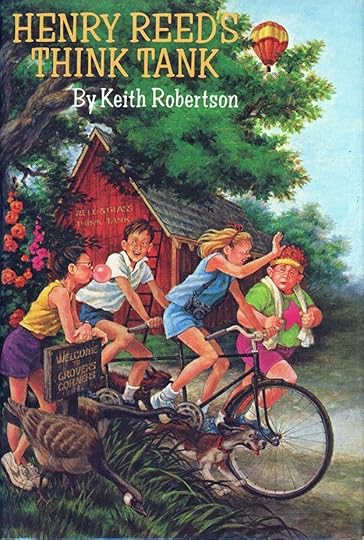 Cover illustration by Gail Owens
Cover illustration by Gail OwensThe fifth and final book in the delightful Henry Reed series was published in 1986, sixteen years after book four in 1970. After such a long gap, I might have expected the writing to be different, but in fact it’s just the same, funny and entertaining adventures of Henry and his business partner and friend Midge Glass in the small, rural New Jersey town of Grover’s Corner near Princeton. What is missing is the wonderful illustrations of Robert McCloskey, who was such an important addition to the previous books. McCloskey was in his early seventies when this was being done, and probably retired from illustration work. In fact, the previous Henry Reed book may have been his final job. Gail Owens did her best, I’m sure, on the cover of this one, but it’s nowhere close to what McCloskey brought to the characters, and in a style so different it seems completely wrong to me. There are no interior illustrations.
The story actually picks up right after book four, Henry Reed’s Big Show, on August 18 of the same summer as that event. The one thing that seems a bit odd when reading the two books close together is that Midge’s horse Galileo, who was a major part of the previous book and living in the barn, is not mentioned at all in this one.
Henry has decided to start a think tank in his barn, something popular in the Princeton area, and a possible way to make some money that doesn’t involve anything other than brain power. Their first clients, as you might expect, are other children in the area. Deirdre asks them to help her get a raise in her allowance. Henry puts together a survey with questions about allowances, and he and Midge collect data from everyone they can. Henry then prepares a report for Deirdre to give her father, who is so impressed he more than doubles her allowance. Henry and Midge’s think tank has their first success!
Some other projects don’t go as smoothly, as you might imagine, and there are plenty of roadblocks for the enterprising pair to overcome, and many funny situations they find themselves in. Author Keith Robertson has no trouble returning to his most popular characters in this last book, and it’s just as good as the rest. Recommended.
Here’s the entire series on Amazon, or look for them wherever you buy used books. Great summer reading.
&amp;lt;br /&amp;gt;&lt;br /&gt;<br /><br />
&lt;br /&gt;<br /><br />
<br /><br />
<br />
The post Rereading: HENRY REED’S THINK TANK by Keith Robertson appeared first on Todd's Blog.
August 14, 2020
Ira Schnapp in ALL-STAR COMICS & SENSATION COMICS
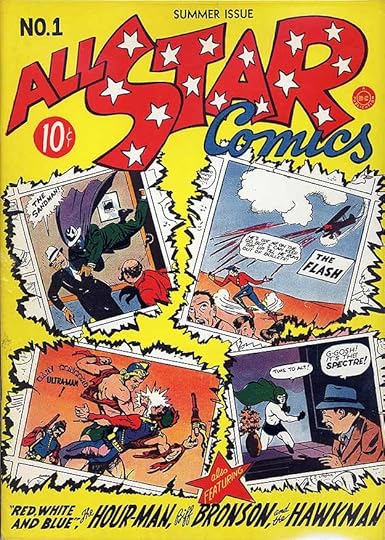 This and all images © DC Comics
This and all images © DC ComicsALL-STAR COMICS was first published by All-American Comics, the sister company of DC (National) Comics in 1940 and ran to issue #57 cover dated Feb/March 1951. It was an anthology featuring many of All-American’s characters and is most famous as the home of the Justice Society of America beginning with issue #3, and the first appearance of Wonder Woman in issue #8. When All-American merged to a shared office with DC in 1946, the title continued for a while edited by Sheldon Mayer, the original editor, but was later handled by Julius Schwartz, who also came over to DC from All-American. Ira Schnapp did no work for All-American, but did work on some of their titles after the merge. On this one he only lettered some covers. As I have less of his work to discuss than usual, I’m going to show all of them.
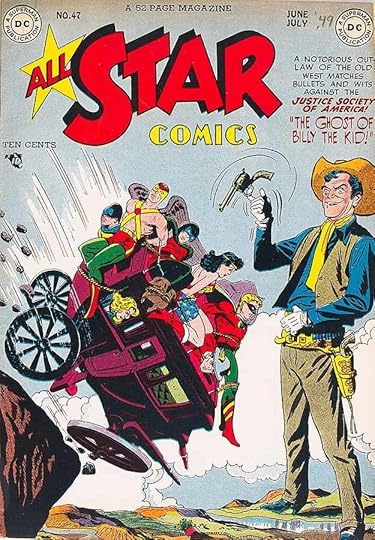
First, here’s cover lettering by someone else, I don’t know who, on issue #47, June/July 1949 to provide contrast. Nothing close to Ira’s work here.
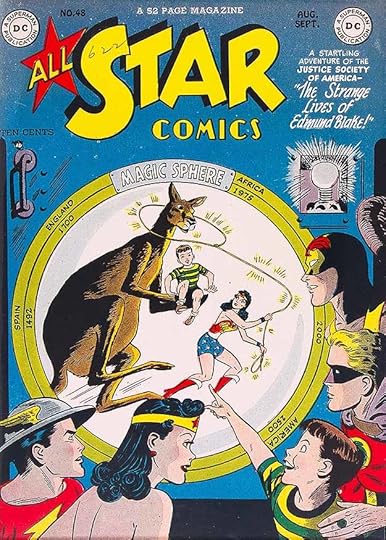
The cover blurb on issue #48 at upper right is much more typical of Ira Schnapp’s work, though the lettering in the art might be by someone else.
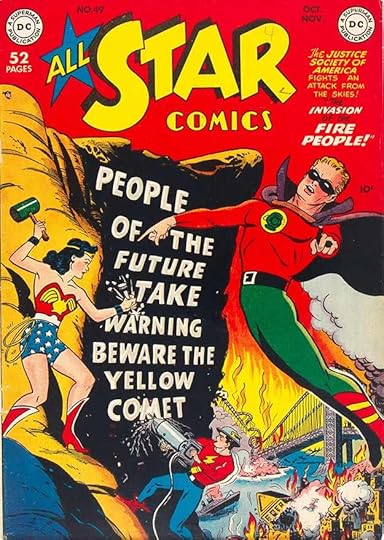
Again, the upper right blurb is by Ira on issue #49, I don’t know if he was involved in the large block lettering in the art. He might have been, it’s similar to other things he did.
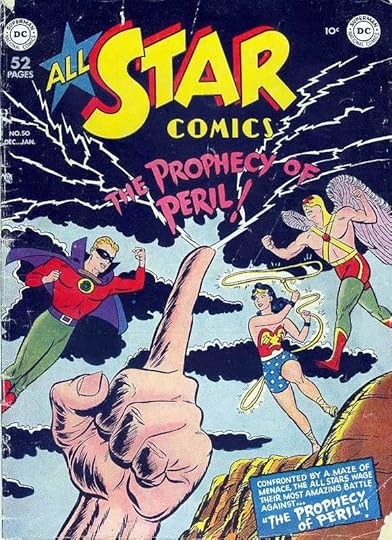
Issue #50 has the story title in the caption at lower right and also floating in the sky above, an unusual repetition. Perhaps Julie Schwartz felt it needed more emphasis. I think it’s the same lettering.
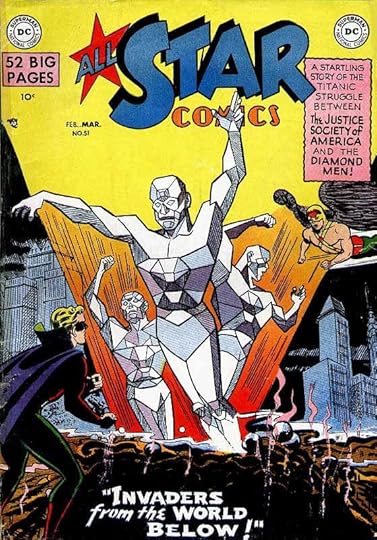
Ira’s title lettering at the bottom of issue #51 just misses being trimmed off on this copy, but on other copies it was probably further from the edge. Comics printing and trimming was not very precise at the time.
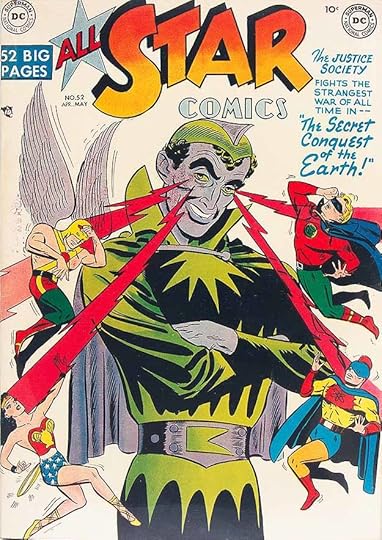
Ira’s blurb at upper right works well in blue ink on a white background here on issue #52.
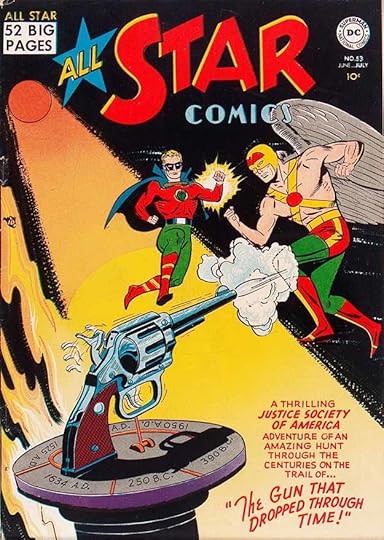
This one on issue #53 works equally well in red on a yellow background. Again, I’m not sure if the lettering on the art is Ira’s or the cover artist’s.
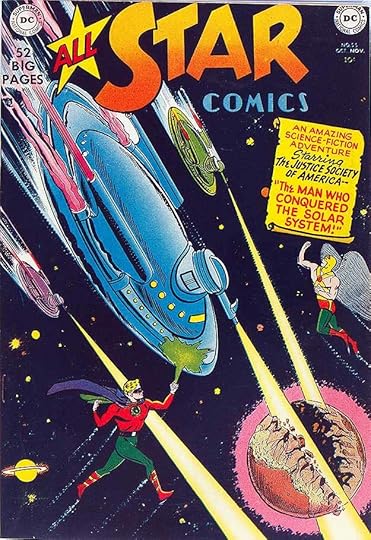
Issue #55 has the cover blurb in a handsome scroll caption, something Ira did not do often.
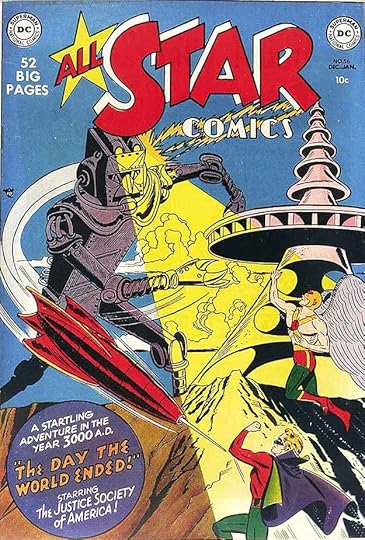
The caption on issue #56 is in a circle with some of it reversed as white on the purple background. This was always risky at the time because if the red and blue plates did not line up perfectly in printing, it would be hard to read, but it works fine here.
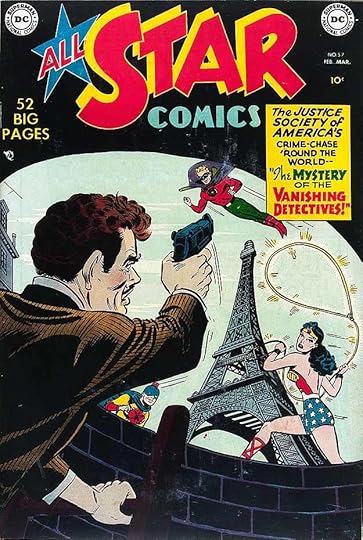
Ira’s blurb on the final cover, issue #57, works fine. In fact, it was the comic that was disappearing, not to be revived until the 1970s, though of course Wonder Woman continued in her own title. That’s the extend of Ira Schnapp’s work on ALL-STAR COMICS, nine covers.
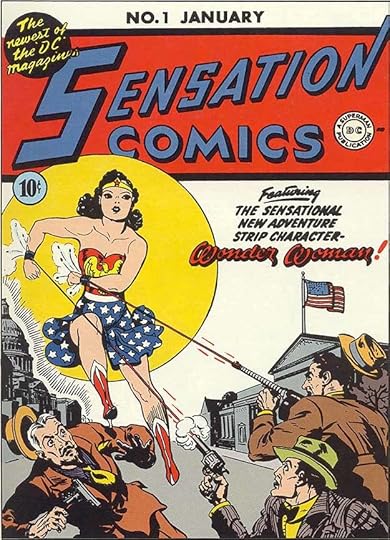
SENSATION COMICS was the new title created for Wonder Woman at All-American Comics, and it ran from January 1942 to issue #109 dated May/June 1952, though by then Wonder Woman had exited. The book was initially edited by Sheldon Mayer with help from Julius Schwartz and Ted Udall. When All-American merged with DC, Mayer continued to be listed as editor, but he had assistance from Robert Kanigher, who took over as full editor in the late 1940s. While Wonder Woman was the book’s star, other characters and series also appeared in each issue. As before, Ira Schnapp did no work for the title until well after the merge.
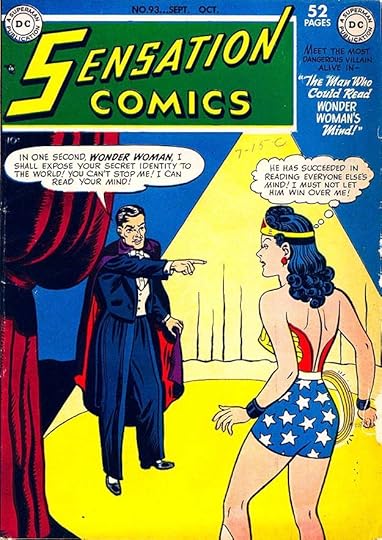
Many issues of the title had no cover lettering. When that became more regular, the style varied, and was not by Ira Schnapp, as in this example on #93, Sept/Oct 1949.
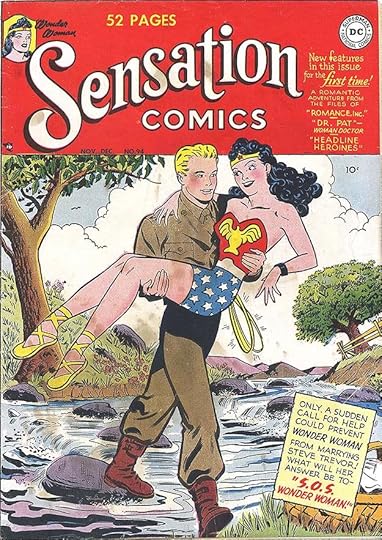
With issue #94 both the logo and the cover lettering gained appeal under the hand of Ira Schnapp. I like his logo much better than the original, and his lettering in the blurb at upper right and the caption add interest to this and future covers.
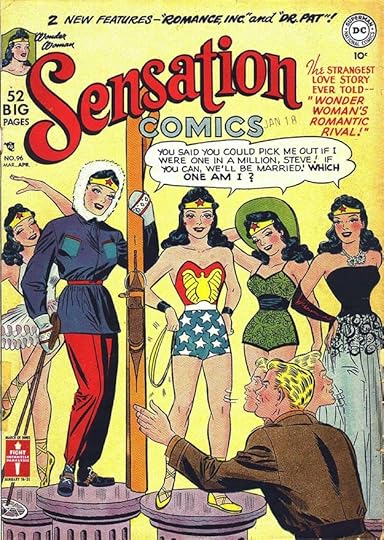
Issue #96, March/April 1950, has the first typical Schnapp word balloon, though the top line lettering is not by him. Under Kanigher, the title was trying to emphasize a romance comic approach for Wonder Woman here.
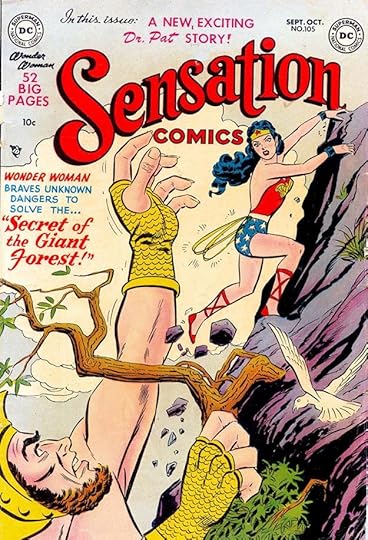
A variety of story approaches followed, suggesting sales were slipping and Kanigher was trying to see what would attract readers. I like Ira’s story title on this one, issue #105, which has a fantasy feel.
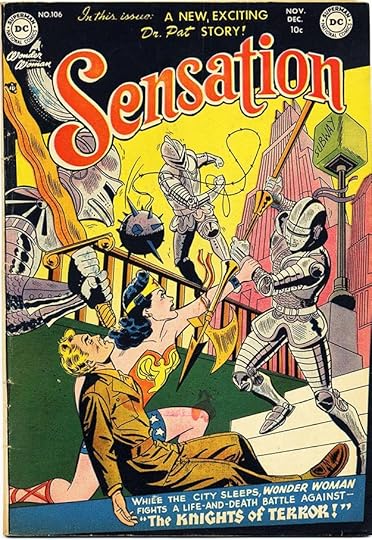
In the next issue, #106, Ira had a chance to use his Old English style in the story title for this very different direction. It was Wonder Woman’s last cover appearance, as the book turned into a mystery anthology.
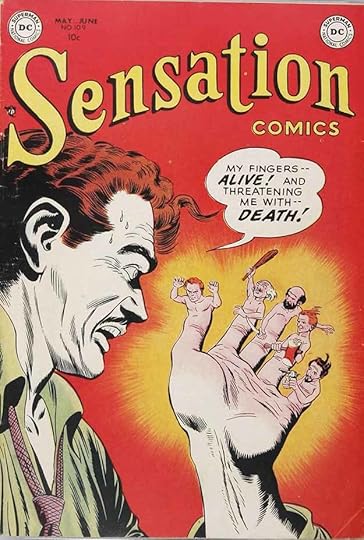
The final issue, #109, is an example of that, and uses an idea that was repeated some years later on a JUSTICE LEAGUE OF AMERICA cover. Sensation was not quite finished, though.
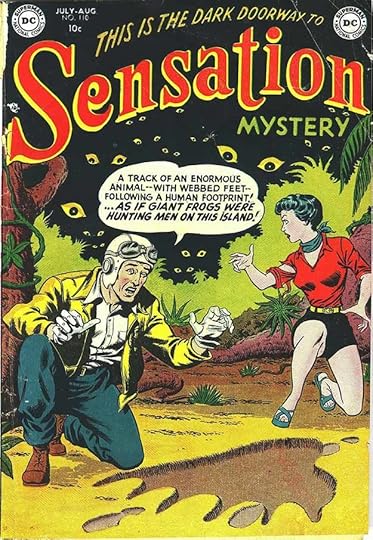
With issue #110, July/Aug 1952, the title changed to SENSATION MYSTERY to better reflect the contents, and put it in the same genre as DC’s HOUSE OF MYSTERY and similar titles. Ira continued to letter the covers. Editing was probably taken over by Julius Schwartz.
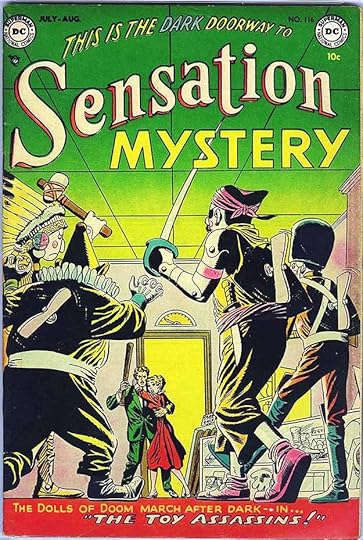
This short-lived version of SENSATION ended with #116, July/Aug 1953, having not found a new audience to keep it going. Ira Schnapp lettered these SENSATION covers:
94, 96-97, 99, 102, 104-116, eighteen in all.
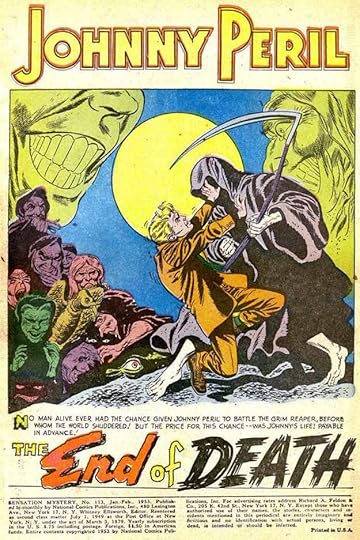
Ira lettered no stories for SENSATION and only two for SENSATION MYSTERY, in issue #113, shown here, and issue #114. Here are the details:
#113 Jan/Feb 1953: Johnny Peril 8pp
#114 March/April 1953: “Return of Cagliostro” 6pp.
More articles in this series can be found on the Comics Creation page of my blog as well as other articles about Ira Schnapp and other letterers.
All-Star Comics on Wikipedia.
The post Ira Schnapp in ALL-STAR COMICS & SENSATION COMICS appeared first on Todd's Blog.
August 12, 2020
Ira Schnapp in A DATE WITH JUDY
 This and all images © DC Comics
This and all images © DC ComicsDC Comics (then National Comics) had a long-standing involvement with radio drama beginning with their own affiliated Adventures of Superman radio show that ran for over 2000 episodes from 1940 to 1951. DC had entered the teen humor genre with BUZZY in 1944, and in 1947 they began this new teen humor series based on a popular radio show that ran from 1941 to 1950, which also inspired a 1948 film and, briefly, a TV show. Archie Comics was doing very well with their teen humor titles, and I think DC did okay with theirs, but it was never a major part of the company’s output. The theme, as you might imagine, was dating, and some stories featured Judy’s brother Randolph and Judy’s friends, but most focused on Judy, her family, and her boyfriend Oogie. Larry Nadle edited. The first issue debuted with an Oct/Nov 1947 cover date, and I think the cover lettering and logo are by the unknown letterer I’ve nicknamed Proto-Schnapp because I believe he was an older man whose work was a major inspiration for Ira Schnapp’s own lettering. Proto-Schnapp was the main letterer and cover letterer for the book until early 1950 or so, though many early covers had no word balloons or captions.

Issue #25, Oct/Nov 1950 has the first cover lettering I think is by Ira Schnapp, with some interesting wavery lettering.

Issue #28, April/May 1952 has the first typical Ira Schnapp cover lettering in the style familiar from many DC titles of the time. From then on, Ira’s balloons were a regular feature on the covers.

A few covers, like this one for #56, Jan. 1957, had a four-panel story where Ira’s lettering was an interesting blend of his cover and interior page work.

Covers late in the series like this one, probably by Bob Oksner, emphasized the character’s sex appeal perhaps in an attempt to hold onto a dwindling audience, but inside Judy was usually more likely to hold Oogie at bay. Ira Schnapp’s cover lettering always helped sell the joke.
Here are the covers I see Ira’s lettering on: 25, 28-30, 33–36, 38-43, 45-48, 50, 52-60, 62-79. That’s 46 covers.

This interior page from issue #1 looks at first glance like the work of Ira Schnapp, but notice how wide many of the letters are, while Ira’s were usually narrower. This is Proto-Schnapp at his best, and his emphasized words on this title are often unusually large or open letters, and rarely italic. Perhaps this was his attempt to mimic the melodramatic delivery of the radio show actors.

With issue #19 dated Oct/Nov 1950, Ira Schnapp page lettering begins appearing regularly, and he generally replaced Proto-Schnapp as the main letterer of the series, though others did stories occasionally. At first Ira tried to copy the larger non-italic emphasis of Proto-Schnapp, but it’s not quite as well done, and notice how most of Ira’s letters would fit into a square.

By issue #25 dated Oct/Nov 1951, Ira had reverted to his usual style for emphasis: italic and bolder but not usually larger than the other lettering.

Stories lettered by Proto-Schnapp occasionally appeared as late as this one in issue #40 dated April/May 1954. I think Proto-Schnapp stopped lettering some time in late 1949, either he retired or died, so it’s likely these later examples were held in inventory for a long time. On a title like this with no continuity to speak of, that was easy to do.

Here’s an example of Ira’s lettering from the same issue for comparison. Many of their letter shapes are the same, but Ira’s are narrower and his emphasized words are handled differently. The balloon styles are nearly identical, something I think Ira took from Proto-Schnapp.

Ira sometimes also lettered short informational features on dating like this one, though I think here he did not do the balloon shapes. Ira was the main letterer on this book from 1951 to 1960. Here’s a list of the stories he worked on. All stories star Judy unless otherwise noted.
#19 Oct/Nov 1950: 6pp, 6pp, 7pp, Randolph 5pp, 6pp, 6pp
#20 Dec 1950/Jan 1951: 2nd story only 6pp
#21 Feb/March 1951: Randolph 5pp, Judy 7pp (last story)
#22 April/May 1951: 9pp, 5pp, Willy Nilly 5pp, 7pp
#23 June/July 1951: Randolph 6pp, 7pp, 9pp
#24 Aug/Sept 1951: 8pp, 6pp, Randolph 6pp, 7pp, 8pp
#25 Oct/Nov 1951: 8pp, 7pp, Pam 3pp, 10pp
#26 Dec 1951/Jan 1952: 8pp, 7pp, 6pp
#27 Feb/March 1952: (not 1st story), 6pp, Pam 3pp, 10pp
#28 April/May 1952: 8pp, 4pp, 5pp, Fittin’ Thing 2pp, Randolph 6pp, (not last story)
#29 June/July 1952: 8pp, 6pp, Randolph 6pp, 9pp
#30 Aug/Sept 1952: 8pp (1st story), Randolph 4pp
#31 Oct/Nov 1952: 8pp, Coby 4pp, 7pp, Designs on You 2pp, Randolph 5pp, 7pp
#32 Dec 1952/Jan 1953: 6pp, 6pp, Randolph 5pp, Date Duds 2pp, 6pp (last story)
#33 Feb/March 1953: 6pp, 6pp, Date Duds 2pp, Randolph 5pp, Rusty 6pp, 7pp
#34 April/May 1953: 6pp, 6pp, 6pp, 6pp, 6pp
#35 June/July 1953: (first two not Schnapp), Tips to Teens 2pp, 6pp, 6pp, 6pp
#36 Aug/Sept 1953: (first two not Schnapp), 3pp, 6pp
#37 Oct/Nov 1953: 6pp, 6pp, Date Duds 2pp, 6pp, Rusty 6pp, 7pp
#38 Dec 1953/Jan 1954: 6pp, 6pp, (3rd not Schnapp), 5pp
#39 Feb/March 1954: (1st not Schnapp), Datewise 2pp, 9pp, Willy 6pp, 9pp
#40 April/May 1954: 6pp, (2nd not Schnapp), 6pp, Tips to Teens 2pp, 6pp (last story)
#41 June/July 1954: 6pp, 6pp, Tips to Teens 2pp, Liz 7pp, 6pp, 6pp
#42 Aug/Sept 1954: 6pp, 6pp, Coby 6pp, 6pp
#43 Oct/Nov 1954: 6pp, 6pp, Datewise 2pp, Liz 5pp, 6pp
#44 Dec 1954/Jan 1955: 6pp, 4pp, (3rd story not Schnapp), Kitty Karr 3pp, 6pp
#45 Feb/March 1955: 6pp, (2nd story not Schnapp), Liz 6pp
#46 April/May 1955: (first two stories not Schnapp), Tips to Teens 2pp, Liz 4pp, 6pp
#47 June/July 1955: (1st story not Schnapp), 6pp, Liz 6pp, 4pp (last story)
#48 Aug/Sept 1955: 6pp, 4pp, Coby 4pp, 6pp
#49 Oct/Nov 1955: 6pp, 6pp, (Liz not Schnapp), 6pp
#50 Dec 1955/Jan 1956: 6pp, 6pp, 6pp, 6pp
#51 Feb/March 1956: 6pp, 6pp, 6pp, 6pp
#52 April/May 1956: 6pp, 6pp, Fittin’ Thing 2pp, Liz 6pp, 6pp
#53 June/July 1956: 6pp, 4pp, 4pp, (Liz not Schnapp), 6pp
#54 Aug/Sept 1956: 6pp, (2nd story not Schnapp), Liz 6pp, 6pp (last story)
#55 Oct/Nov 1956: 6pp, 6pp, 4pp, 6pp
#56 Dec 1956/Jan 1957: (1st story not Schnapp), 6pp, 4pp, 6pp
#57 Feb/March 1957: (1st story not Schnapp), 6pp, Buzzy 6pp, 6pp
#58 April/May 1957: 6pp, 4pp, (Buzzy not Schnapp), 4pp, 6pp
#59 June/July 1957: 6pp, Datewise 2pp, Harvey 6pp, 6pp
#60 Aug/Sept 1957: (1st story not Schnapp), 6pp, Harvey 6pp
#61 Oct/Nov 1957: 6pp, 6pp, 6pp, 6pp
#62 Dec 1957/Jan 1958: 6pp, 6pp, Coby 3pp, 6pp
#63 Feb/March 1958: 6pp, Tips to Teens 2pp, 6pp
#64 April/May 1958: (1st story not Schnapp), Tips to Teens 2pp, 6pp, 6pp
#65 June/July 1958: 12pp, 6pp, 6pp
#66 Aug/Sept 1958: 12pp, Judy’s Tips 2pp, 6pp, 6pp
#67 Oct/Nov 1958: 12pp, 6pp, 6pp
#68 Dec 1958/Jan 1959: 12pp, Date Duds 2pp, Willy 7pp
#69 Feb/March 1959: 12pp, Tips to Teens 2pp, 6pp (last story)
#70 April/May 1959: 12pp, Tips to Teens 2pp, 6pp, 6pp
#71 June/July 1959: 6pp, Tips to Teens 2pp, 6pp, 12pp
#72 Aug/Sept 1959: 10pp, Fashion 2pp, 8pp, 6pp
#73 Oct/Nov 1959: 10pp, Pinups 2pp, 8pp, 6pp
#74 Dec 1959/Jan 1960: no story lettering by Ira
#75 Feb/March 1960: 12pp, 5pp, Tall Tales 2pp, 8pp
#76 April/May 1960: 12pp, On the Beach 1pp, 10pp, 5pp
#77 June/July 1960: 12pp, 8pp, 6pp
#78 Aug/Sept 1960: 12pp, Teen Talk 1pp, 8pp, 6pp
#79 Oct/Nov 1960: 12pp, 6pp, 6pp, Teen Age 1pp
That’s a total of 1,316 pages if my math is right. And there are plenty of other titles with just as much for this busy letterer! More articles in this series can be found on my Comics Creation page.
A Date With Judy on Wikipedia.
The post Ira Schnapp in A DATE WITH JUDY appeared first on Todd's Blog.
August 10, 2020
And Then I Read: DRAGONFLY & DRAGONFLYMAN 5
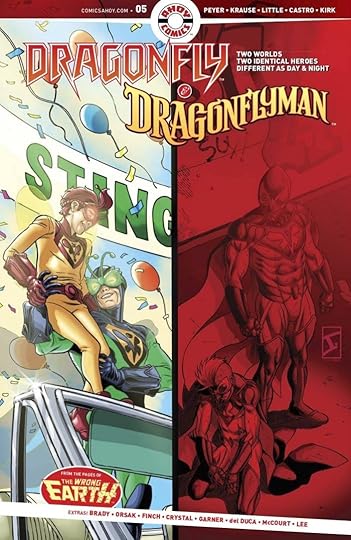 Image © Ahoy Comics. Written by Tom Peyer, art by Peter Krause.
Image © Ahoy Comics. Written by Tom Peyer, art by Peter Krause.This series continues to have fun with the concept introduced in THE WRONG EARTH, two versions of superhero adventures, one looking back to the 1960s in feel and one in today’s grim and gritty world. The two play off each other with very different results as this season ends.
On Earth Omega, Dragonfly’s young partner is fed up with the ill-treatment he feels he’s been given by his boss, and is trying to walk away, while a new potential partner surfaces. On Earth Alpha, Dragonflyman’s partner Stinger has found new ways to help his partner, and is about to be rewarded for it.
Clearly things are set for another season ahead. I look forward to it. This one is now collected in the book below. Recommended.
The post And Then I Read: DRAGONFLY & DRAGONFLYMAN 5 appeared first on Todd's Blog.
August 8, 2020
Ira Schnapp in COMIC CAVALCADE
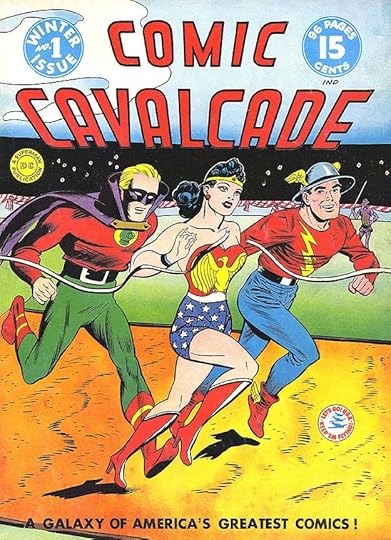 This and all images © DC Comics.
This and all images © DC Comics.All-American Comics, a sister company to DC Comics in the early 1940s because of some shared owners, had success with their superheroes Green Lantern, Wonder Woman and Flash. In addition to one or more titles where they appeared solo, they teamed up in ALL-STAR COMICS and this title, COMIC CAVALCADE, though they actually appeared together mostly on the cover, the stories inside were usually unrelated to each other. When All-American and DC (National) merged in 1946, All-American editor-in-chief Sheldon Mayer continued to manage his titles for a while, but they were gradually integrated into the DC line. Some long-time DC editors like Julius Schwartz began at All-American. Mayer moved on to full-time freelance work for the company as an artist and writer/artist, and he did that the rest of his life. COMIC CAVALCADE #1 was dated Winter 1942. Ira Schnapp did no work for the All-American line until after the merge in 1946.
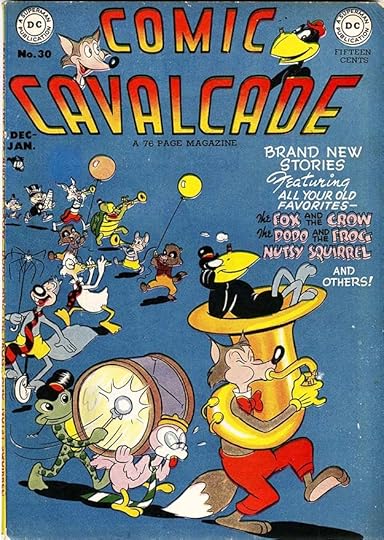
With issue #30 dated Dec. 1948/Jan. 1949, the superheroes moved out and funny animals, many already appearing in other DC Comics, moved in. At this time the funny-animal creators and personnel from DC followed, with the book now edited by Larry Nadle, who handled most of DC’s humor titles. It was a big book, 76 pages initially, and the stories were short, so there was room for lots of features and creators. Lettering by the unknown person I’ve nicknamed Proto-Schnapp (because I think his work was the model for Ira’s lettering) began showing up, as on this cover, and on inside stories. Ira’s work also began on story pages with issue #30, along with many others whose names I don’t know.
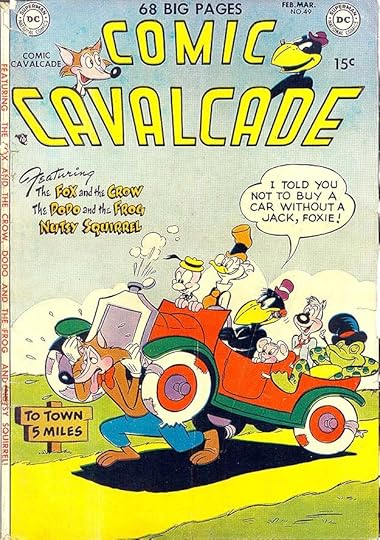
Many of the issues had no cover lettering other than the “Featuring” blurb by Proto-Schnapp that continued to be used. Issue #49 dated Feb.-Mar. 1952, is the first one with a typical Ira Schnapp cover balloon, as seen on every title in the DC line through the 1950s and early 1960s. His style on covers was larger, more careful, and more precise than his inside page lettering.
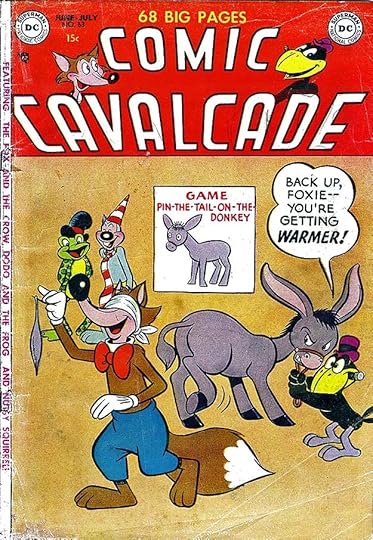
Ira’s cover lettering appeared on a few more covers, including the final one of the series, shown here, from 1954.
Here are the covers I see Ira’s work on: 49, 51, 53, 56, 57, 59, 61-63. That’s nine covers.
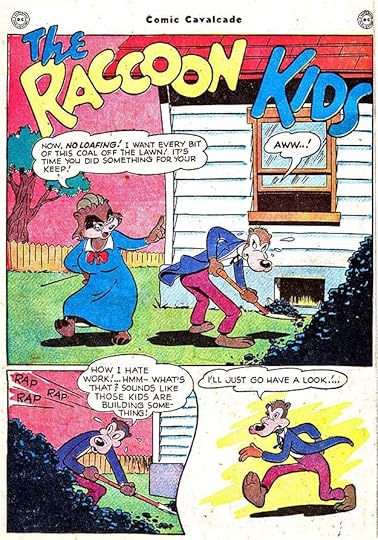
Many of the interior stories Ira lettered, like this one from issue #31 dated Feb.-March 1949, were features that also appeared in other DC titles like FUNNY FOLKS and ANIMAL ANTICS. I think editor Larry Nadle was able to move excess inventory from those titles into this one if he needed to, as it was a larger book. Proto-Schnapp’s work on inside pages appeared in the 1949 issues, then vanished, I think because he either retired or died. By late 1950 Ira was lettering about a third of the stories, with a variety of other letterers whose names are now unknown doing the rest. Ira’s lettering is very regular, with most letters fitting into a square, and his balloon shapes were artfully scalloped, often overlapping the panel borders above to fit things in.
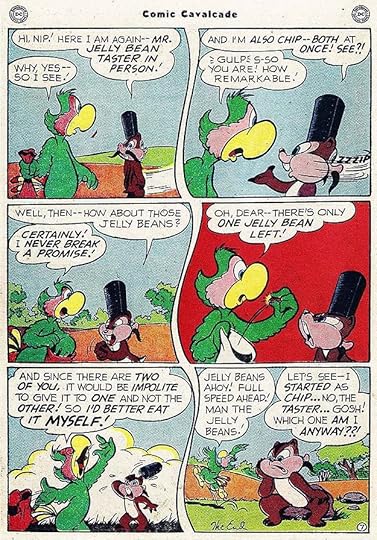
Ira’s lettering on this Nip and Chip story from issue #37, Feb.-March 1950, is larger than usual, perhaps because he had the room.
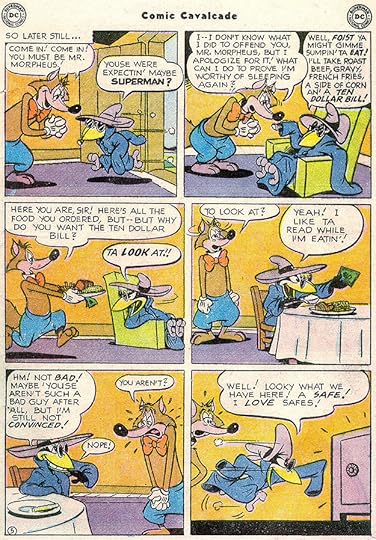
While scanning through the issues, I was startled to find this Fox and Crow story in issue #45 with the Crow pretending to be Morpheus, the Greek god of sleep, in order to fool the Fox. It’s an interesting premonition of the 1980’s SANDMAN series written by Neil Gaiman, who told me he never saw it or any Fox and Crow stories. Comics expert Mark Evanier pointed out that the artist, James Davis, who was in California, pencilled and inked the art and balloon borders before sending the pages to DC in New York, where Ira Schnapp would have received them to letter. This is the likely reason many of the funny animal stories he and other letterers did have oddly-shaped or misfit balloons: the artists, who may also have been working as animators in California, put them in before the lettering, and Ira and his colleagues had to make the lettering fit as best they could. Mark wonders if the extra space in the last panel might have been where editor Larry Nadle cut some of the dialogue in the original script, which artist Davis would have pencilled on the page to estimate the balloon size.
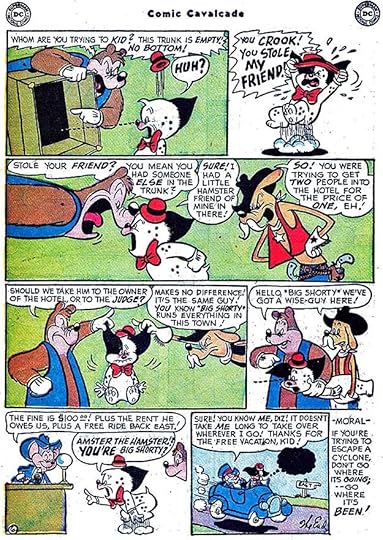
Some of the humor artists were in New York, too. Shelly Mayer did lots of stories for the series, like this Dizzy Dog one from issue #53. Here Ira would have received the pencilled art to letter and put in his own balloon shapes. There’s quite a lot of lettering on this page also written by Mayer, but at least he left room for it, though spacing is tight in spots.
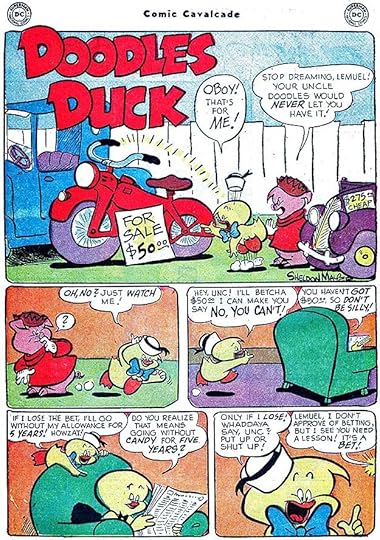
A story from the final issue, #63, dated June-July 1954, also by Mayer and Schnapp. I must admit that I never bought or read any of DC’s humor titles growing up. My limited funds and buying opportunities were focused on superhero comics. I didn’t come to appreciate the fine work of Sheldon Mayer until much later.
Here’s a list of all the inside stories I believe are lettered by Ira Schnapp in this series:
#30 Dec 1948/Jan 1949: Goofy Goose 6pp
#31 Feb/March 1949: Raccoon Kids 6pp
#34 Aug/Sept 1949: Ozzie Owl 6pp
#35 Oct/Nov 1949: Goofy Goose 5pp, Roly & Poly 6pp, Ozzie Owl 5pp
#36 Dec 1949/Jan 1950: J. Rufus Lion 7pp, Dodo & the Frog 6pp
#37 Feb/March 1950: Blabber Mouse 6pp, Raccoon Kids 5pp, J. Rufus Lion 6pp, Ozzie Owl 6pp, Nip & Chip 7pp
#38 April/May 1950: Blabber Mouse 6pp, Pete the Pup 6pp, Goofy Goose 6pp, Custer Cat & Cheesy Mouse 6pp, Nutsy Squirrel 6pp
#39 June/July 1950: Fox & Crow 8pp, Blabber Mouse 7pp, Custer & Cheesy 6pp, Dodo & Frog 5pp, JR Lion 7pp, Nip & Chip 6pp
#40 Aug/Sept 1950: Dodo & Frog 6pp, Doodles Duck 6pp, Ruff & Reddy 7pp, Goofy Goose 6pp, Nutsy Squirrel 6pp
#41 Oct/Nov 1950: Fox & Crow 8pp, Dizzy Dog 8pp, Bo Bunny 6pp, Doodles Duck 8pp
#42 Dec 1951/ Jan 1952: Fox & Crow 8pp, Blabber Mouse 5pp, Bo Bunny 4pp, Dodo & Frog 6pp, Bernard the Brave 6pp
#43 Feb/March 1951: Fox & Crow 8pp, Bo Bunny 6pp, Nutsy Squirrel 7pp
#44 April/May 1951: Dizzy Dog 6pp, Doodles Duck 5pp, Blabber Mouse 6pp
#45 June/July 1951: Fox & Crow 8pp, Fox & Crow 1pp
#46 Aug/Sept 1951: Raccoon Kids 6pp, Doodles Duck 6pp, JR Lion 6pp, Goofy Goose 6pp
#47 Oct/Nov 1951: Raccoon Kids 6pp, Presto Pete 6pp, Dizzy Dog 6pp, Dodo & Frog 9pp
#48 Dec 1951/Jan 1952: Tortoise & Hare 6pp, Fraidy Cat 5pp, Dodo & Frog 3pp, Doodles Duck 5pp, Nutsy Squirrel 6pp
#49 Feb/March 1952: Fraidy Cat 6pp, Bo Bunny 6pp, Custer & Cheesy 5pp, Doodles Duck 6pp, Nutsy Squirrel 5pp
#50 April/May 1952: Dizzy Dog 6pp, Doodles Duck 5pp, Blabber Mouse 6pp
#51 June/July 1952: Raccoon Kids 5pp, Bo Bunny 6pp, Dodo & Frog 6pp, Nutsy Squirrel 5pp
#52 Aug/Sept 1952: Custer & Cheesy 6pp, Bo Bunny 6pp, Tortoise & Hare 4pp, Blabber Mouse 5pp
#53 Oct/Nov 1952: Fox & Crow 6pp, Fraidy Cat 4pp, Raccoon Kids 5pp, Bernard 4pp, Dizzy 6pp, Nip & Chip 4pp, Pinky & Winky 4pp, Bo Bunny 6pp
#54 Dec 1952/Jan 1953: Fox & Crow 6pp, Nutsy Squirrel 5pp, Dodo & Frog 4pp, Bernard 4pp, Doodles Duck 6pp, Dizzy Dog 6pp, Nip & Chip 4pp, Bo Bunny 6pp, Roly & Poly 4pp
#55 Feb/March 1953: Nutsy Squirrel 6pp, Bernard 4pp, Tortoise & Hare 4pp, Roly & Poly 4pp, Blabber Mouse 4pp
#56 April/May 1953: Fox & Crow 6pp, Nutsy Squirrel 6pp, Dizzy Dog 6pp, Bo Bunny 6pp, Goofy Goose 4pp
#57 June/July 1953: Fox & Crow 6pp, Blackie Bear 4pp, Dizzy Dog 6pp, Nip & Chip 4pp, Doodles Duck 6pp
#58 Aug/Sept 1953: Nutsy Squirrel 5pp, Doodles Duck 6pp, Nip & Chip 4pp, Dizzy Dog 6pp
#59 Oct/Nov 1953: Dodo & Frog 4pp, Doodles Duck 6pp, Nip & Chip 4pp
#60 Dec 1953/Jan 1954: Fox & Crow 6pp, Doodles Duck 6pp, Dodo & Frog 6pp, Goofy Goose 4pp, Nip & Chip4pp, Dizzy Dog 6pp
#61 Feb/March 1954: Fox & Crow 6pp, Doodles Duck 6pp, Dizzy Dog 6pp, Bo Bunny 6pp, Nip & Chip 5pp, Custer & Cheesy 4pp, Bernard 4pp
#62 April/May 1954: Fox & Crow 6pp, Doodles Duck 4pp, Dodo & Frog 5pp, Nutsy Squirrel 7pp, Dizzy Dog 6pp, Tortoise & Hare 4pp, Goofy Goose 6pp
#63 June/July 1954: Fox & Crow 6pp, Nutsy Squirrel 5pp, Doodles Duck 5pp, Nip & Chip 4pp, Fraidy Cat 4pp
That’s a total of 775 pages if my math is right. More articles in this series can be found on the Comics Creation page of my blog.
The post Ira Schnapp in COMIC CAVALCADE appeared first on Todd's Blog.
August 7, 2020
And Then I Read: THE DRAGON TREE by Jane Langton

The eighth and final book in the Hall Family series was published in 2008, but I missed it until recently. The Halls live on Walden Street in Concord, Massachusetts. Professor Frederick Hall spends much of his time writing a book about his idol Henry Thoreau. His wife, Professor Alexandra Hall cares for him and their children. Eleanor, the oldest, is away studying in Paris, but the younger children Edward and his sister Georgie are still at home and bear witness to the latest magical event the house and family are famous for.
A new neighbor, Mr. Moon, has moved in next door, and he loves to cut down trees, not only on his own property, but he’s working for the town and convincing them many of their trees must go. As if in response, a magical tree, the Dragon Tree, sprouts on the property line between the Halls and the Moons. It grows with surprising and magical quickness, and soon the Halls must keep a careful watch over it to prevent Mr. Moon from cutting it down. They build a tree house to help with that. Mrs. Moon is always ready to help her husband, but their niece Emerald, who works as a servant for the Moons, finds herself strangely attracted to the Halls and their tree, which soon gets her into trouble with the Moons.
This is a fun and quick read, it moves along at almost as fast a pace as the tree grows. For once the magic seems to come from the ground itself rather than some enchanted object, and the Hall family are as charming as ever, while the Moons are as villainous as every Langton villain. Langton died in 2018, so there will be no more of the series. Someday I will reread the earlier ones, but this book stands on its own perfectly well.
Recommended.
More about Jane Langton.
The post And Then I Read: THE DRAGON TREE by Jane Langton appeared first on Todd's Blog.
August 5, 2020
Ira Schnapp in ANIMAL ANTICS & FUNNY FOLKS
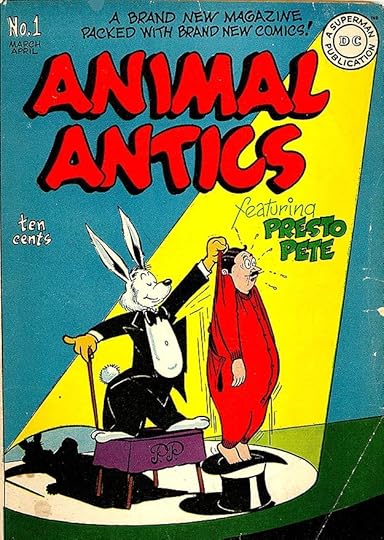 This and all images © DC Comics
This and all images © DC ComicsWorking my way through DC titles of the 1940s looking for lettering work by Ira Schnapp, this title ran for 23 issues from March/April 1946 to Nov/Dec 1949. Then the title changed to MOVETOWN’S ANIMAL ANTICS, which I’ll cover later. It was edited by Bernie Breslauer initially, and later by Larry Nadle. While searching for Ira’s work, I’m finding lots more by the unknown letterer I’ve nicknamed Proto-Schnapp because I think he was an older man working on staff at DC as a letterer and that Ira used his work as a model for his own. Some of the familiar display lettering styles that Ira adopted came from Proto-Schnapp, but Proto had others that Ira didn’t use. This first cover for the series has good examples: the bouncy, curly top line lettering, the style of upper and lower case used for “featuring,” and the very lively and appealing open letters for “Presto Pete.” I’m now thinking this logo is also by Proto-Schnapp as he liked rounded, bouncy letters more than Ira. Much of the cover and interior lettering in this title, nearly all of it, is by Proto-Schnapp too.
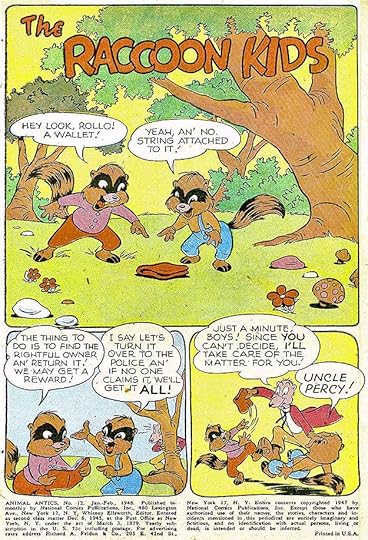
Here’s an example of Proto-Schnapp’s work from issue #12, Jan/Feb 1948. At first glance it looks like Ira’s lettering, and I thought that for some time, but look how wide and curvy many of the letters are.
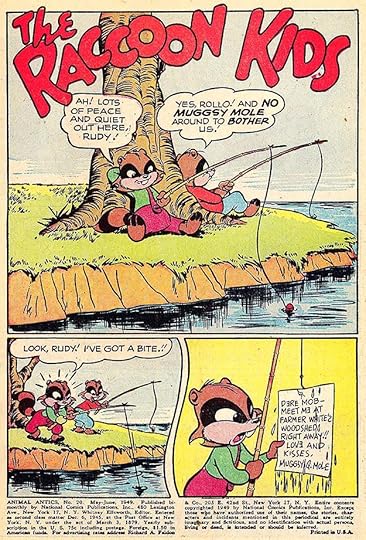
By issue #18, Proto-Schnapp’s story lettering had dwindled to a few stories per issue. In #20, Proto-Schnapp is still lettering the lead feature, The Racoon Kids, above…
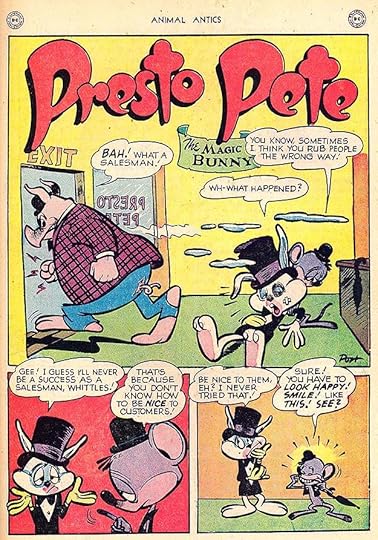
…but compare it to this story which I think is lettered by Ira Schnapp. The letters are narrower, most would fit into a square, and his treatment of the emphasized words is just different from Proto’s. The Presto Pete logo is probably by Proto-Schnapp from earlier in the series. This is the only Ira lettering in issue 20.
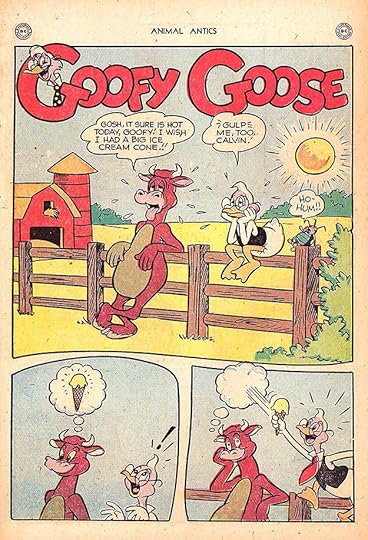
But in issue #21, there are five stories lettered by Ira, including Goofy Goose. Again, the logo is from previous issues and probably by Proto-Schnapp. This is nearing the end of the time I find any work at DC from Proto-Schnapp, who may have retired or died in 1949.
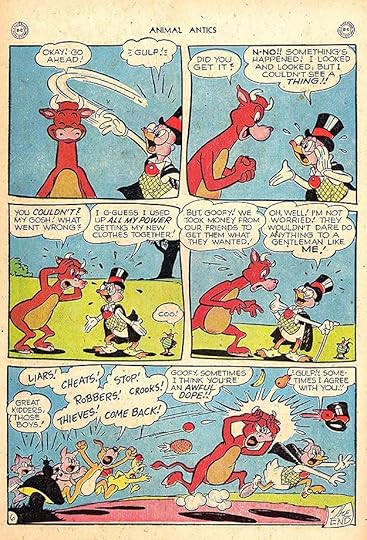
The final page of the Goofy Goose story in issue #21 is a better example of Ira’s work, especially all the emphasized words. Issues #22-23 also each had several stories lettered by Ira. I’m sure I’ll find lots more when I cover the continuation of this title later, but here’s a summary of Ira Schapp lettering in these 23 issues:
#20 May/June 1949: Presto Pete 6pp
#21 July/Aug 1949: Raccoon Kids 6pp, Nip & Chip 7pp, Pete the Pup 6pp, Goofy Goose 6pp, Ozzy Owl 5pp
#22 Sept/Oct 1949: Raccoon Kids 6pp, Nip & Chip 5pp, Custer Cat & Cheesy the Mouse 6pp, Goofy Goose 6pp, Racoon Kids 5pp
#23 Nov/Dec 1949: Raccoon Kids 5pp, Nutsy Squirrel 1pp, Ozzie Owl 6pp
That’s a mere 76 pages of Ira lettering this time, and no covers.
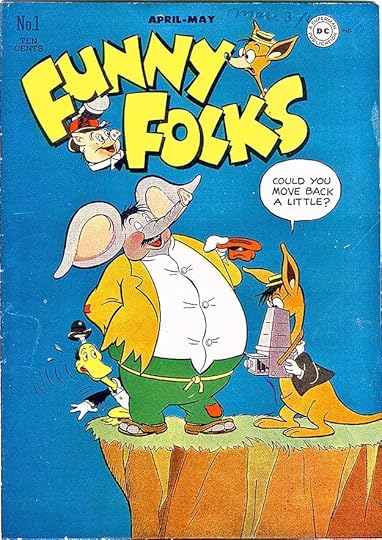
Around the same time in early 1946 that ANIMAL ANTICS was begun at DC, their sister company All-American Comics launched this similar anthology of funny animal stories. It was edited by Sheldon Mayer, a fine funny animal artist himself, and I think he designed the logo, as it’s similar in style to Mayer’s own creation SCRIBBLY. As far as I’ve discovered, Ira Schnapp did no work for All-American titles until after the companies were combined later in 1946. Mayer continued to edit this one for a while, using his own stable of creators.

Some of the lettering, like this page from issue #15, was excellent, but I don’t know who did it. It reminds me of the lettering of Ben Oda at the time, but isn’t quite the same as that, so the letterer remains unknown. At some point the editing was turned over to Larry Nadle, who handled most of DC’s humor titles, and then lettering by Proto-Schnapp shows up, but rarely.
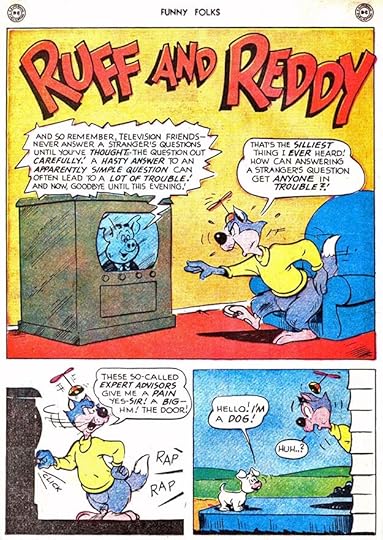
This story from issue #22, Oct/Nov 1949 has the first Ira Schnapp lettering I see in the title on a feature with the same name as the 1950s cartoon series, but unrelated.
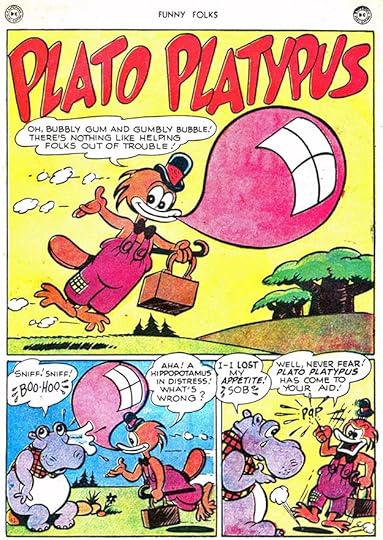
Also in issue #22 is this story lettered by Ira, though the logo may have been designed by Proto-Schnapp in a previous issue.
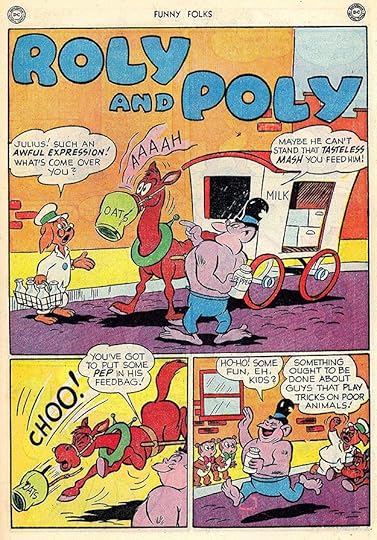
There were a few Ira Schnapp-lettered stories in issues 23-24 and 26, including this one from that final issue of the series, which was renamed HOLLYWOOD FUNNY FOLKS with issue #16, but not in the indicia until #27. Despite that name change, I don’t think any of the characters in it appeared in cartoons. I’ll cover the issues using that official title later. Only a few covers in this run of FUNNY FOLKS had any cover lettering, and none is by Ira. Here’s a list of the stories he lettered:
#22 Oct/Nov 1949: Ruff & Reddy 7pp, Plato Platypus 6pp
#23 Dec 1949/Jan 1950: Plato Platypus 5pp, Nip and Chip 6pp, Ozzie Owl 6pp
#24 Feb/March 1950: Nip and Chip 6pp
#26 June/July 1950: Roly and Poly 6pp, Nip and Chip 7pp, Ham Hocks 7pp, Nutsy Squirrel 7pp
That’s 63 pages, again not a lot for Ira. More articles in this series can be found on the Comics Creation page of my blog.
The post Ira Schnapp in ANIMAL ANTICS & FUNNY FOLKS appeared first on Todd's Blog.
Todd Klein's Blog
- Todd Klein's profile
- 28 followers



